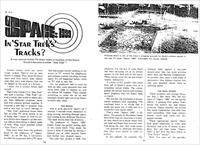Criticism
In Star Trek's Tracks
Unknown publication, p10-13


A new science fiction TV show looks at humans of the future. Could it become another "Star Trek"?
Science fiction buffs are pretty tough cookies. They're not an easy bunch to please. They know all about space and time travel, laser beams, stars that nova, and planets that can be zapped at the push of a button.
I know. I'm a science fiction buff myself.
That's why I think TV's "Star Trek" was such a success. "Star Trek" created a whole new world in which people from different countries, races, and even planets worked together. It invented a new way to measure time and a new way to travel through it.
"Star Trek' portrayed future ideas like no other TV show, movie, or set of books that 1 know of. And we science fiction fans lapped it up like starlost kittens discovering a planet mode of milk. What could possibly follow "Star Trek's" act?
That must have been the problem faced by the producers of "Space: 1999." As an SF fan, I certainly wouldn't be impressed with a TV show that had people merely walking on the moon, or TV screens for telephones, and ordinary rockets travelling through space. It's all happened before -- both on TV and in real life.
No, the producers had to come up with an idea, some gimmick that had never been used, to impress me and my fellow SF buddies. They needed something to make me sit up and transport myself right out of my down-to-earth easy chair.
And a good gimmick wasn't all I wanted. I wanted those characters to keep moving, travelling through space, and coming across different life-forms. The show would need lots of action.
The producers of "Space: 1999" finally found the perfect setting right in the moon itself. They made the moon a kind of starship, by having it blasted out of orbit around Earth and hurled into deepest space.
The year they picked is 1999. The situation: For the last 24 Years Earth has been dumping all of its atomic wastes on the dark side of' the moon. These wastes never die out and always remain radioactive.
A colony of 311 people -- who came from all of Earth's races -- live in a moonbase called Alpha. The colony guards the atomic wastes and oversees space programs that are begun back on Earth.
But one day the stockpiles of atomic wastes suddenly start exploding. The combined blast is so strong that it sends the moon out of orbit and on a course for -- who knows what?
That's what "Space: 1999" is all about. The people on Moonbase Alpha have little hope for returning to Earth. So they search for a planet where they can land and begin their lives all over. And along the way, they come across -- you guessed it -- different life-forms that they must battle in order to survive.
In one episode. for example. The Alphans fight against a one-eyed people- eater that has more pivoting arms, than the Harlem Globetrotters, In another, they meet a man made of antimatter, one Alphan touches him and gets knocked flatter than an unflying saucer.
These monsters and strange beings are fine. I like them. But the real stars of "Space: 1999" are the special effects. A glowing blue sphere float across the moon's sky and freezes everyone. Space shuttles zip around like metal cockroaches that wish they were butterflies. And huge planets almost touch and crash - but disappear instead.
These spectacular special effects look great - especially in colour - and obviously cost a lot of money to produce. But can they make "Space: 1999'' a hit? Will the show follow in "Star Trek's" tracks?
Well, I've seen all the episodes that have been shown so far. And I've certainly enjoyed them. But "Space: 1999" has a few flaws that are worth considering. So --- let's consider them.
It doesn't seem likely. For one thing, it took 11 years just for the U.S. to put Neil Armstrong on the moon. The space program started in 1958; Armstrong landed in 1969.
For another, our space program has slowed down for now. How could we hope to build such a large moonbase with all its trimmings in only 24 years? We'd have to start yesterday. And we'd have to have been dumping our atomic wastes on the moon years ago in order to create an explosion big enough to knock it out of orbit.
So far-not so good.
But even if all of Earth's atomic wastes were stored on the far side of the moon, their explosion would send the moon on a collision course toward Earth. And that never happens in "Space: 1999."
Strike two.
For instance, a person would walk six times slower, jump six times higher, and lift six times the weight of what could be lifted on Earth. Now, this is what appears to happen when the characters in "Space: 1999" are outside the moonbase and on the moon's surface. But once inside the base, everyone moves as if back on Earth. How is this explained?
It isn't.
I don't think so. For one thing, it would take a drifting moon 800 years to reach the nearest star system that had its own planets. Science fiction writer Isaac Asimov pointed this out in a recent newspaper article.
The spaceship Enterprise on "Star Trek" was able to travel great distances because its speed could be controlled. And it was able to go faster than the speed of light.
The moon in "Space: 1999" can't be controlled. It's merely drifting.
That's four flaws. And here's a fifth:
But so "Space: 1999" has a few flaws. So what? I still think it's terrific. And apparently so do a lot of other people - even the experts.
Isaac Asimov wants the show to succeed because he enjoys it. And Dr. Wernher von Braun recommends the show too. He's only the president of the National Space Institute.
And so then, do I think "Space: 1999" will follow in "Star Trek's" tracks? No. I think it will make its own path among the stars.
Edward J Zagorski
Captioned photos: